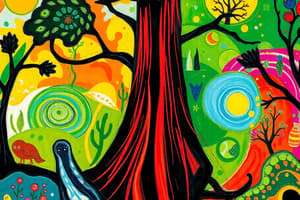Podcast
Questions and Answers
What is the primary purpose of pesticides in an ecosystem?
What is the primary purpose of pesticides in an ecosystem?
To control pests and prevent damage to crops and non-target organisms.
What is the difference between biomagnification and bioaccumulation?
What is the difference between biomagnification and bioaccumulation?
Biomagnification refers to the increase in concentration of a toxin as it moves up the food chain, while bioaccumulation is the accumulation of toxins in an organism over time.
What is an ecosystem and how do biotic and abiotic factors interact within it?
What is an ecosystem and how do biotic and abiotic factors interact within it?
An ecosystem is a community of living and non-living things interacting with each other in a specific environment. Biotic factors are living things like plants, animals, and microorganisms, while abiotic factors are non-living things like water, soil, and sunlight. These factors interact to create a delicate balance and support life within the ecosystem.
How do human activities contribute to eutrophication?
How do human activities contribute to eutrophication?
What is the role of producers in an ecosystem, and how do they produce energy?
What is the role of producers in an ecosystem, and how do they produce energy?
What is the role of decomposers in an ecosystem?
What is the role of decomposers in an ecosystem?
Describe the difference between a food chain and a food web, and give an example of each.
Describe the difference between a food chain and a food web, and give an example of each.
Why do consumers not obtain 100% of the energy from their food?
Why do consumers not obtain 100% of the energy from their food?
What is the carbon cycle, and what are the main reservoirs and processes involved?
What is the carbon cycle, and what are the main reservoirs and processes involved?
What is a limiting factor, and how does it relate to carrying capacity?
What is a limiting factor, and how does it relate to carrying capacity?
What is the relationship between fertilizer use and eutrophication?
What is the relationship between fertilizer use and eutrophication?
What is an example of mutualism, commensalism, and parasitism, and how do they differ?
What is an example of mutualism, commensalism, and parasitism, and how do they differ?
What is the role of the three spheres (lithosphere, atmosphere, and hydrosphere) in supporting life on Earth?
What is the role of the three spheres (lithosphere, atmosphere, and hydrosphere) in supporting life on Earth?
What is the difference between native and non-native species, and what are the consequences of non-native invasive species?
What is the difference between native and non-native species, and what are the consequences of non-native invasive species?
How does the pesticide PCB influence organisms within an ecosystem?
How does the pesticide PCB influence organisms within an ecosystem?
What is eutrophication, and what are its consequences for ecosystems?
What is eutrophication, and what are its consequences for ecosystems?
Flashcards are hidden until you start studying
Study Notes
Ecosystem
- An ecosystem consists of biotic (living) and abiotic (non-living) factors
- Biotic factors: organisms, community, population
- Abiotic factors: lithosphere, hydrosphere, atmosphere, biosphere
- The four spheres interact and relate to each other
Producers and Consumers
- Producers: autotrophs, make own food using chlorophyll and light energy
- Consumers: heterotrophs, obtain energy by consuming other organisms
- Types of consumers: omnivore, carnivore, herbivore, scavenger
Energy in an Ecosystem
- Types of energy: radiant, thermal, light
- Energy source: photosynthesis
- Equation: 6CO2 + 6H2O + light energy → C6H12O6 (glucose) + 6O2
- Cellular respiration: opposite of photosynthesis, releases energy from glucose
Food Chains and Webs
- Food chain: series of organisms that eat other organisms
- Food web: complex network of food chains
- Trophic levels: producers, primary consumers, secondary consumers, etc.
- Drawing and interpreting food chains and webs involves understanding trophic levels
Pyramids
- Types of pyramids: numbers, energy, biomass
- Each type represents a different aspect of an ecosystem
- Pyramids show the relationship between trophic levels
The Carbon Cycle
- Processes: photosynthesis, decomposition, respiration
- Reservoirs: atmosphere, oceans, land, fossil fuels
- Carbon cycle: movement of carbon between reservoirs and processes
Ecosystem Interactions
- Examples of interactions: competition, predation, symbiosis
- Mutualism: both organisms benefit
- Commensalism: one organism benefits, the other is not affected
- Parasitism: one organism benefits, the other is harmed
Limiting Factors
- Causes: temperature, light, water, nutrients, predators
- Relationship between limiting factors and carrying capacity
- Graphs related to carrying capacity: exponential growth, equilibrium
Biodiversity
- Importance: variety of species, ecosystems, and genes
- Examples of low and high biodiversity
- Human activities decreasing biodiversity: habitat destruction, pollution, climate change
Non-Native Invasive Species
- How it happens: introduction of non-native species through human activity
- Why it's a problem: disrupts ecosystem balance, outcompetes native species
- Control methods: eradication, containment, education
Pests and Poisons
- Pests: organisms that harm ecosystems or human health
- Pesticides: used to control pests, types: insecticides, herbicides, fungicides
- Issues with pesticides: biomagnification, bioaccumulation
Eutrophication
- How it happens: excess nutrients, usually from fertilizers, enter ecosystem
- Human contribution: agricultural runoff, sewage
- Effects: excessive algal growth, decreased oxygen levels, harm to aquatic life
Studying That Suits You
Use AI to generate personalized quizzes and flashcards to suit your learning preferences.




